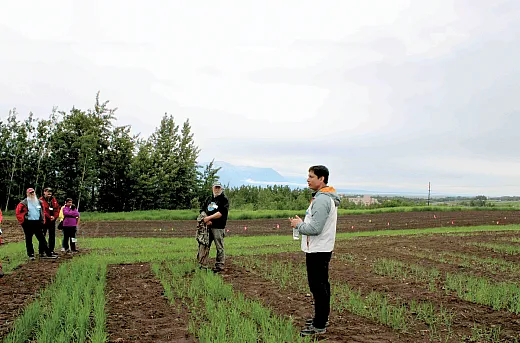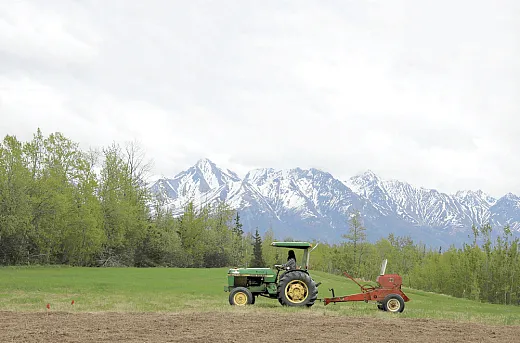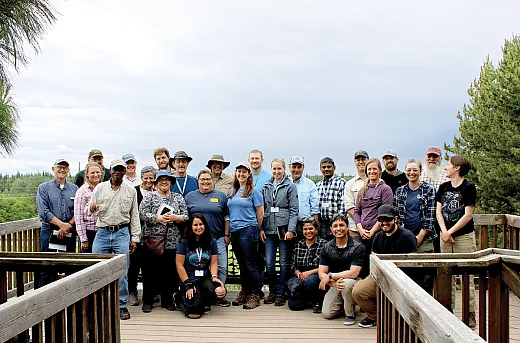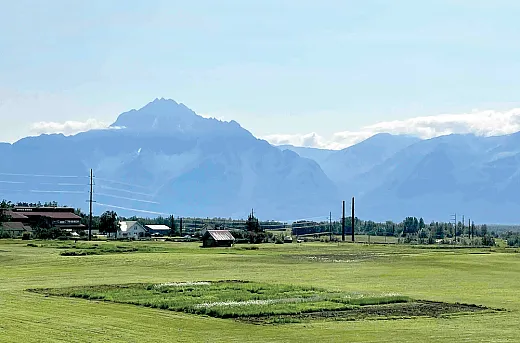Growing Small Grains in Sub-Arctic Alaska
Breeding Barley, Studying Soil, and Focusing on Farmers in the Last Frontier

- The largest state in the U.S., Alaska has only 1% of it’s land devoted to agriculture. Yet, there’s a strong need for and interest in increasing local production to help fortify food security in the state.
- The Alaska Collaborative Food Production Systems Project develops research projects and supports agricultural producers in the state.
- At the 2023 ASA, CSSA, and SSSA Annual Meeting, researchers from the team talked about the project’s objectives and progress. With one growing season under their belts, they’ve made headway on breeding trials, gathered novel data on soil health and quality, finished a year of cover crop trials, and interviewed producers and consumers about food agency in the state.
It’s a well‐worn observation, but the sheer size of Alaska is staggering. The largest state in the U.S., its area is larger than the next three biggest states—Texas, California, and Montana—combined.
Less than 1% of that area is devoted to agriculture. But that doesn’t mean Alaska is not fertile ground for farming. By the USDA’s count, the state has the highest rate of new and beginning farmers in the U.S. Farmers successfully grow barley, potatoes, specialty crops, and flowers. And there’s a strong need for and interest in increasing local production to help fortify food security in the state, which relies heavily on imports.
“The demand for locally produced food and sustainable farm practices is very high because of our geographic isolation, and the agricultural science that happens elsewhere doesn’t necessarily translate well to our unique environment and growing conditions,” says Caley Gasch, a soil scientist at the University of Alaska Fairbanks (UAF).
The Alaska Collaborative Food Production Systems Project, a collaboration between UAF and the USDA‐ARS Northern Great Plains Research Laboratory in Mandan, ND and the Edward T. Schafer Agricultural Research Center in Fargo, ND, aims to fill that gap. As Alaska does not have full‐time ARS staff, the cooperative agreement between the institutions develops research projects and supports agricultural producers in the state. The collaboration also includes producers and community stakeholders.
Researchers from the team presented the project’s objectives and progress at the 2023 ASA, CSSA, and SSSA Annual Meeting. With one growing season under their belts, they’ve made headway on breeding trials, gathered novel data on soil health and quality, finished a year of cover crop trials, and interviewed producers and consumers about food agency in the state. Here, we talk with Gasch, USDA‐ARS social scientist Claire Friedrichsen, and UAF plant geneticist Jakir Hasan about the project and its goals.

A Short History of Delta Barley
In the late 1970s, Alaska had large budget surpluses to spend due to booming revenue from oil development, and then‐governor Jay Hammond decided that the state needed to broaden its economic base through agriculture. The government focused on Delta Junction, an area in a river valley about 100 miles south of Fairbanks in Alaska’s interior, first. They auctioned off more than 80,000 acres of state‐owned land for farmers to grow barley, which has a short growing season and can mature at cooler temperatures. “The goal was to increase food security for the state and produce more agricultural output,” Gasch says. In 1982, the state agency managing the program predicted half a million acres would be in cultivation by 1992.
But as the political winds shifted, support for the project waned. Promised infrastructure was never built, funding was cut, and other initiatives stalled. By 1998, only seven of the original 37 landowners from the original Delta sales retained ownership of the land. Many of the farmers had foreclosed and gone into significant debt. “There were a lot of farmers that burned out,” says ASA member Claire Friedrichsen.
However, barley lives on in the region with its farmers currently producing spring barley as well as spring oats and spring wheat. According to the most recent USDA National Agricultural Statistics Service Census of Agriculture, there were 22 farms producing just under 5,000 total acres of barley for grain in all of Alaska in 2022. Most of that grain goes into animal feed though one Delta‐based operation, the Alaska Flour Company, sells barley cereal, brownie mix, and pancake batter via the only commercial flour mill in the state.
Other producers throughout Alaska grow a multitude of vegetables and specialty crops for direct distribution through farmers’ markets or community‐supported agriculture programs. And in July, August, and September, dozens of Alaskan flower farmers export thousands of peony stems around the globe. The cooler climate allows the lucrative flowers to bloom during these months when they don’t in any other part of the world.
A Warming Climate
While it’s a boon for peony exports, unsurprisingly the Alaskan climate presents a challenge to agriculture at large. Long, cold winters stretch from October to April, and the growing season typically ranges from 90 to 120 days. Summer’s long days, clocking as much as 23 hours of sunlight each, help offset the short season.
Alaska is heating up faster than other parts of the globe, and the interior is warming faster than other parts of the state, “which makes the climate more suitable for these types of small‐grain production,” says CSSA member Jakir Hasan. Climate models from UAF’s Scenarios Network for Alaska ± Arctic Planning predict that the growing season in Delta Junction could stretch to 155 days by the end of the 21st century.
Climate change presents an existential threat to Alaskan ecosystems and to the many people and who hunt, gather, and catch wild foods throughout the state. For row crops, the warming temperatures and shifting conditions could allow producers to grow species that haven’t fared well in the past. “We’re interested in reviving some of those questions on what species can we grow in this new and changing climate,” Gasch says.
Breeding New Barley Lines
With their effort to study and breed small‐grain crops in the state, however, the Collaborative Food Production Systems Project first focused on barley (https://bit.ly/3J8TX8k). Over the last few years, Hasan established a brand‐new breeding program at UAF. “We started from nothing,” he says. He built a gene pool from more than 800 germplasm of two‐row and six‐row barley obtained from the USDA‐ARS Germplasm Resources Information Network and the Nordic Genetic Resource Center in Sweden (he also obtained several hundred accessions of wheat and oat) and tested them to see what genotypes grow well in Alaska’s climate. “From those groups of germplasm, we identified a portion that can be introduced to the farmer immediately as a potential variety … to grow on their farm and meet their demand,” Hasan says.
At the same time, the researchers are also developing their own hybrid lines by making crosses with the old Alaskan and Nordic varieties. They made these first crosses last winter and are currently harvesting the F4 generation in the greenhouse, using speed breeding to accelerate the population development.
The researchers will look for traits like early heading, early maturity, and the ability to produce higher grain even in the exceptionally long photoperiod conditions experienced in the Alaskan growing season. “Early maturity is typically linked with poor yield, and therefore, this is one of the trade‐offs. We are looking for the variety that goes into reproductive stage sooner, and at the same time, there is no penalty on grain yield,” Hasan says. This summer, they will plant the climate‐suited selection of germplasm identified in last year’s trial in the field to determine which have the highest yield potential.
Last year, Hasan also planted new test crops that might adapt to the interior Alaskan climate, including Kernza and perennial wheat. “One of our primary objectives is to see whether they have the winter hardiness, whether they will survive through Alaska’s winter or not,” he explains.
Soil Health and Cover Cropping
Hasan’s barley trials also incorporate Gasch’s soil health research. The two are collaborating to investigate the different belowground plant traits of the test barley lines. “I’m excited about the opportunity that a breeding program is considering soil and belowground traits,” Gasch says. Her broader piece of the puzzle is investigating how management practices impact soil health in the state’s different cropping systems. “I’m working with both small‐grain farmers and specialty‐crop farmers to identify management practices that enhance and protect soil.”
Soils in Alaska are young and nutrient‐poor. “It’s fresh glacial till, essentially,” Gasch says. The farms in the state’s interior were carved out of boreal forest and contain shallow and acidic soils. (The boreal forest presents a challenge, too, for expanding agriculture into new areas—that land has to be cleared, and transportation networks through the state are limited.) Sections of the state’s soils have never been fully surveyed and assessed for agricultural potential, Gasch says.

And some farmed soils have permafrost underneath. “That creates a whole other set of challenges,” Gasch says. “If an area that has permafrost is cleared, then the land warms up, and there’s less insulation by the vegetation.” The permafrost can thaw and change the topography of the field. “It’s not as big of a problem on the small‐grain farms, because those have been cleared and farmed since the ‘80s,” she says. “But certainly as agriculture continues to expand in the state, that is a challenge for new land as it’s cleared and potentially experiences that permafrost thaw.”
For the farmers Gasch works with, nutrient availability is a main concern. “Synthetic fertilizer is expensive, and it’s subject to supply chain disruption because of our location,” she says. In her research program, she is currently testing cover crops in small‐grain and potato systems. “Can we find local sources of fertility to meet the crop demands at scale?”
In the project’s first growing season, Gasch’s goal was to see what cover crops could successfully grow (https://bit.ly/3TKaQuW). She put together a group of species potentially cold hardy enough for the climate, including several varieties of alfalfa, clovers, buckwheat, radishes, rapeseed, cereal rye, camelina, flax, and legumes, of particular interest for their ability to contribute nitrogen to the system.
They found a good amount of growth for many of the tested species, Gasch reports. “And we had a couple of surprises.” The camelina and flax were able to produce mature seeds, so they’ll explore those as a potential cash crop going forward, she says. This year, the researchers will trial mixes of cover crops designed for specific crop rotations at two locations—with potatoes in Palmer in south‐central Alaska and with barley up in the interior in Fairbanks—and assess their nutrient contributions and biomass production.
Food Agency and Craft Breweries
This summer, Gasch also plans to work with Friedrichsen to assess how implementing cover crops contributes to farmers’ day‐to‐day stress and well‐being. “We’re trying to figure out a way to measure that and also compare and contrast that with other intangible, non‐economic outcomes of soil health practices,” Friedrichsen says.
As an expert in the human dimensions of soil management, Friedrichsen works to understand how humans make decisions, interact with, and value soil. For the Collaborative Food Production Systems Project, she is developing a new tool to measure the concept of food agency, a construct additional to food security, among several populations connected to agriculture in the state. “Food security is a static construct that measures if people have food right now on their table or within the last month,” she explains, while food agency is the ability of participants in the food system to make and meet goals around food.

To create the tool, Friedrichsen conducts qualitative case studies, interviewing members of a specific population in a specific context about their food production goals and barriers to reaching them. She first focused on the small‐grain industry in Alaska, holding unstructured interviews with small‐grain farmers as well as tractor companies, fertilizer companies, and the buyers of the barley—livestock producers, bakers, and even brewers.
Alaska is home to many craft breweries and distilleries and a robust tourism industry. During this winter’s case study, Friedrichsen and the team learned that the breweries wanted locally grown malting barley to use in their operations.
“Currently they are relying solely on import to meet their demand,” Hasan explains. “But they’re also interested in having access to Alaska‐grown malting barley.” He’s now collaborating with the University of Minnesota to test winter malting barley in Alaska to meet that need.
Overall, Friedrichsen describes the uniting objective of the Collaborative Food Production Systems Project as such: “How can we strengthen Alaskan identity around agriculture, and how can we foster that?” Growing grains in Alaska for Alaska‐made products is one avenue.
“Through this agreement, we’re able to address those needs,” Gasch says of the project. “There’s a lot to be done,” she adds, “But I think the impact is going to be very big for Alaska.”

Dig Deeper
Watch some presentations recorded at the 2023 ASA, CSSA, and SSSA Annual Meeting related to the research discussed in this article:
Evaluating Cover Crops for Agricultural Systems in Alaska: https://bit.ly/3TKaQuW
Alaskan Agriculture and the Collaborative Food Production Systems Research Project: https://bit.ly/3WnVr6s
Small Grain Crops Breeding for the Sub‐Arctic Climate in Interior Alaska: https://bit.ly/3J8TX8k
Text © . The authors. CC BY-NC-ND 4.0. Except where otherwise noted, images are subject to copyright. Any reuse without express permission from the copyright owner is prohibited.










